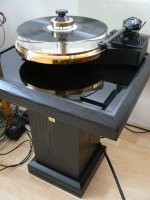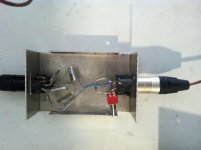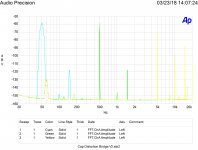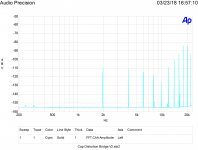Hi Bill,
The Thorens tables I've owned have bettered anything from Technics. That is unless you gut the table and replace the bearings too. At that point I would argue that it is no longer a Technics product. The Linn tables are also pretty darned good as well.
Have you seen those new tables with 12" thick (or more) metal platters that weigh god knows how much? One wonders what kind of bearing can withstand that pressure, and how long do they last? That is sure taking things to extremes!
-Chris
The Thorens tables I've owned have bettered anything from Technics. That is unless you gut the table and replace the bearings too. At that point I would argue that it is no longer a Technics product. The Linn tables are also pretty darned good as well.
Have you seen those new tables with 12" thick (or more) metal platters that weigh god knows how much? One wonders what kind of bearing can withstand that pressure, and how long do they last? That is sure taking things to extremes!
-Chris
Saying nothing as I once lusted after one of these (I was young). JPs measurements were I think a stock bearing. They are very good at what matters for turning round. Arm I agree is not the best. However I think you get burned at the stake for pointing out that drive method doesn't actually matter as long as you know how to fettle it properly 
Attachments
If there's an appropriately designed thrust bearing at the bottom of it, then it shouldn't be a problem to have a gigantic platter. Hardly in the grand scale of mechanical engineering that humanity has pursued. Like, say, putting things in space or aligning a Michelson-Morely interferometer to gravitational wave sensitivity, or building the systems to smash gold atoms at at highly relativistic speeds. 
If you should ask whether I think it's ridiculous, then that's a different question entirely! I'd rather a highly sampled means of determining rotation and some learning algorithms that "predistort" the motor drive to keep everything running (perfectly) smooth.
I'd rather a highly sampled means of determining rotation and some learning algorithms that "predistort" the motor drive to keep everything running (perfectly) smooth.
If you should ask whether I think it's ridiculous, then that's a different question entirely!
Saying nothing as I once lusted after one of these (I was young).
Looks like re-purposed shop equipment. The current fad of one off over the top turntables is like making a silk purse out of a Mac truck.
Last edited:
PMA, you do yourself no favor attacking Fremer if you want to be in the hi end audio community..
Sorry, I do not care at all. He has proven his incompetence many times during last 20 years I have been reading his articles.
Hi Daniel,
I think that those giant tables are pretty unrealistic. Pretty, but can you imagine dusting them all the time?? The ones I saw had two massive platters connected with a shaft that exceeded any reasonable weight. Massive things. Wouldn't want to move one!
-Chris
-Chris
And there's the rub.If there's an appropriately designed thrust bearing at the bottom of it, then it shouldn't be a problem to have a gigantic platter.
I think that those giant tables are pretty unrealistic. Pretty, but can you imagine dusting them all the time?? The ones I saw had two massive platters connected with a shaft that exceeded any reasonable weight. Massive things. Wouldn't want to move one!
-Chris
-Chris
Sorry, I do not care at all. He has proven his incompetence many times during last 20 years I have been reading his articles.
You have been fremed.
Looks like re-purposed shop equipment. The current fad of one off over the top turntables is like making a silk purse out of a Mac truck.
This was in the 80s. Big hair, big shoulderpads, big turntables
Chris: take a (or another) look in the turntable speed thread. You'll see some very interesting analysis there. Not sure if we got a measurement from Kevin's well fettled TD124s or not but thanks to about 25 lines of Python from Scott you can analyse TT basic performance incredible quickly if you know what to look for.
I think that those giant tables are pretty unrealistic. Pretty, but can you imagine dusting them all the time??
Rest assured, we're in full agreement here. Promise!
My obtuse and Friday-centric (to not be taken seriously in any way!) was more that your average delivery truck has tougher bearing challenges than a large platter sitting on a thrust bearing.
This was in the 80s. Big hair, big shoulderpads, big turntablesI also wanted a Goldmund reference. GrooveT I think has one. And a forgiving wife

I knew someone with one the wife came and went, made us her special chocolate mousse, Kraft instant pudding and Coolwhip.
Hi guys 
I sold my G R last year and my wife ist still here, but i am the cook at home.
Now i am listening records with my EMT 930 TT, equipped with Thales Simplicity Arm and Silver Spirit MC. Pretty nice front end imho. Had to fix a lot of problems with 930, but actually it simply works and my spouse like the sound and my food.
I sold my G R last year and my wife ist still here, but i am the cook at home.

Now i am listening records with my EMT 930 TT, equipped with Thales Simplicity Arm and Silver Spirit MC. Pretty nice front end imho. Had to fix a lot of problems with 930, but actually it simply works and my spouse like the sound and my food.
Sorry, I do not care at all. He has proven his incompetence many times during last 20 years I have been reading his articles.
And you are still reading them?
Now that I am almost caught up at work. I have started testing capacitors. The first using 1 uF 50-63 volt units in my 4/1-1/4 bridge at three frequencies (50,500 & 5,000 Hz.) and 18-20 KHz IMD.
TDK CGA5L2COGAH104J160AA 50V NPO .1 uF x 100 pieces sorted and matched for best balance as 1 uF per assemblage.
TDK CGA5L2COGAH104J160AA 50V NPO .1 uF x 100 pieces sorted and matched for best balance as 1 uF per assemblage.
Attachments
Now i am listening records with my EMT 930 TT, equipped with Thales Simplicity Arm and Silver Spirit MC.
Gosh you are slumming it now
Reason for -60dBv? It's quite low...
//
Fundamental is suppressed by the reasonably well matched bridge. It is actually 10 volts or +20dBv. voltage out of the matched bridge not surprisingly runs a millivolt or so.
Derfy, It is a classic 4 unit bridge with all legs having the same value. The technique is that two elements are composed of four capacitors in series parallel so the value stays the same but the voltage across each is 1/2. compared to the other two halves which are single capacitors. So 4 on top on the left to 1 on the bottom and the other side has 1 on top and 4 on the bottom.
I knew someone with one the wife came and went, made us her special chocolate mousse, Kraft instant pudding and Coolwhip.
Good stuff just needs a little Miracle Whip and it would be be good for a family reunion!
Derfy, It is a classic 4 unit bridge with all legs having the same value. The technique is that two elements are composed of four capacitors in series parallel so the value stays the same but the voltage across each is 1/2. compared to the other two halves which are single capacitors. So 4 on top on the left to 1 on the bottom and the other side has 1 on top and 4 on the bottom.
And you're measuring differential voltage between the non driven legs of the bridge, I assume.
I have to run the math/spice it with nonideal capacitors, but don't intuitively see how this produces a more sensitive test. Or what exactly this measures in terms of part distortion.
- Status
- Not open for further replies.
- Home
- Member Areas
- The Lounge
- John Curl's Blowtorch preamplifier part III



